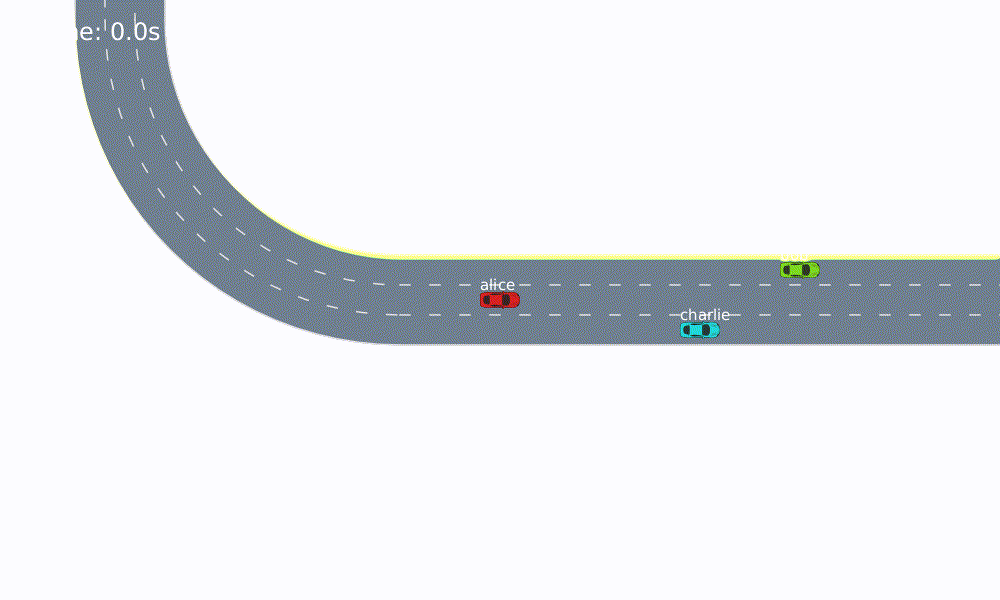Driving in a Stadium
This example demonstrates a 2D driving simulation where cars drive around a three-lane stadium. The entities are defined by the types:
S-VehicleState, containing the vehicle position (both globally and relative to the lane) and speedD-VehicleDef, containing length, width, and classI-Symbol, a unique label for each vehicle
The environment is represented by a Roadway object which allows to define roads consisting of multiple lanes based on the RNDF format.
We load relevant modules and generate a 3-lane stadium roadway:
using AutomotiveDrivingModels
using AutoViz
using Distributions
roadway = gen_stadium_roadway(3)
snapshot = render([roadway])As a next step, let's populate a scene with vehicles
w = DEFAULT_LANE_WIDTH
scene = Frame([
Entity(VehicleState(VecSE2(10.0, -w, 0.0), roadway, 29.0), VehicleDef(), :alice),
Entity(VehicleState(VecSE2(40.0, 0.0, 0.0), roadway, 22.0), VehicleDef(), :bob),
Entity(VehicleState(VecSE2(30.0, -2w, 0.0), roadway, 27.0), VehicleDef(), :charlie),
])
car_colors = get_pastel_car_colors(scene)
renderables = [
roadway,
(FancyCar(car=veh, color=car_colors[veh.id]) for veh in scene)...
]
snapshot = render(renderables)We can assign driver models to each agent and simulate the scenario.
timestep = 0.1
nticks = 300
models = Dict{Symbol, DriverModel}(
:alice => LatLonSeparableDriver( # produces LatLonAccels
ProportionalLaneTracker(), # lateral model
IntelligentDriverModel(), # longitudinal model
),
# :bob => Tim2DDriver(
# timestep, mlane = MOBIL(timestep),
# ),
:bob => StaticDriver{AccelTurnrate, MvNormal}(
MvNormal([0.0,0.0], [1.0,0.1])
),
:charlie => StaticDriver{AccelTurnrate, MvNormal}(
MvNormal([0.0,0.0], [1.0,0.1])
)
)
set_desired_speed!(models[:alice], 12.0)
set_desired_speed!(models[:bob], 10.0)
set_desired_speed!(models[:charlie], 8.0)
scenes = simulate(scene, roadway, models, nticks, timestep)An animation of the simulation can be rendered using the Reel package
using Reel
using Printf
camera = TargetFollowCamera(:alice; zoom=10.)
animation = roll(fps=1.0/timestep, duration=nticks*timestep) do t, dt
i = Int(floor(t/dt)) + 1
update_camera!(camera, scenes[i])
renderables = [
roadway,
(FancyCar(car=veh, color=car_colors[veh.id]) for veh in scenes[i])...,
RenderableOverlay(IDOverlay(x_off=-2, y_off=1), scenes[i], roadway),
TextOverlay(text=[@sprintf("time: %.1fs", t)], pos=VecE2(40,40), font_size=24)
]
render(renderables, camera=camera)
end"animated_stadium.gif"
Alternatively, one can also use the Interact framework to inspect the simulation record interactively.
using Interact
using Reel
using Blink
w = Window()
viz = @manipulate for step in 1 : length(scenes)
render([roadway, scenes[step]])
end
body!(w, viz)The simulation results can be saved to a text file. We achieve this by first converting the list of scene to a Trajdata type and then exporting it.
TODO: fix writing of Trajdata
open("2Dstadium_listrec.txt", "w") do io
@warn "TODO: need to fix bug in write(trajdata)"
# write(io, MIME"text/plain"(), Trajdata(scenes, timestep))
end┌ Warning: TODO: need to fix bug in write(trajdata)
└ @ Main.ex-driving_in_circles none:2The trajectory data file can be loaded in a similar way.
# listrec = open("2Dstadium_listrec.txt", "r") do io
# @warn "TODO: need to fix bug in write(trajdata)"
# read(io, MIME"text/plain"(), Trajdata)
# end
# p = plot(listrec)
# TODO: maybe do something useful with the loaded data, like plot the speed over time or something